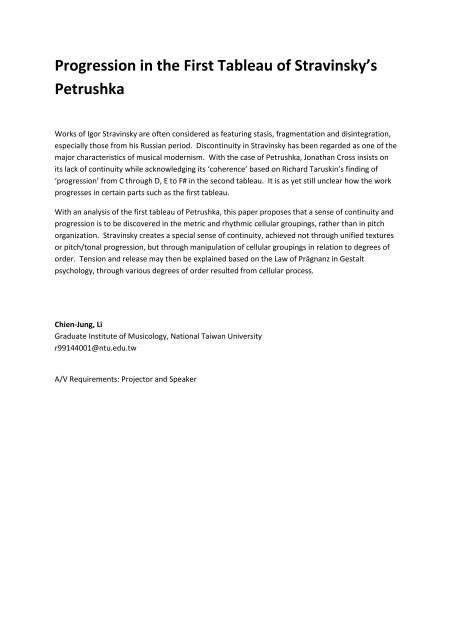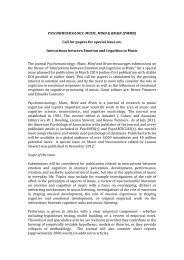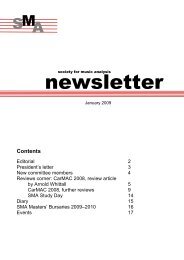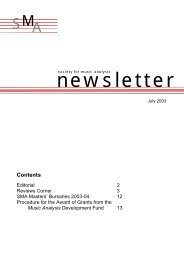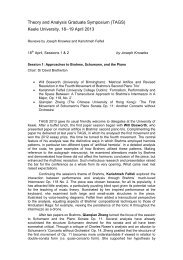Here - Society for Music Analysis
Here - Society for Music Analysis
Here - Society for Music Analysis
Create successful ePaper yourself
Turn your PDF publications into a flip-book with our unique Google optimized e-Paper software.
Large-scale structure in Sergei Prokofiev’s PianoSonata No. 8 in B-flat.While the larger part of musicological study on Sergei Prokofiev remains within the field ofbiography, the analytical study of his music has seen a growing interest in recent decades. Threescholars in particular have published analyses challenging some simplistic, tonally-biased ideasexpressed about Prokofiev’s music in earlier literature. Neil Minturn focuses on the structuralproperties of certain pitch-class sets; Richard Bass explores the interpretation of chromaticphenomena within an expanded framework of tonal functions; while Deborah Rifkin seeks toaddress the purpose behind unusual chromaticisms with her theory of structural motifs. Theirfindings shed light unto hitherto unexplained phenomena in Prokofiev’s music, while supporting theexisting observation that his musical style consists of an eclectic mixture of classical and modernelements.One area of study which has received relatively little attention is the large-scale construction inProkofiev’s works. While some scholars have noted that Prokofiev has a tendency to employ clearlydefined classical <strong>for</strong>ms, the exploration of the harmonic <strong>for</strong>ces conventionally governing these <strong>for</strong>mshas been taken <strong>for</strong> granted. I believe this is a significant over-sight, as the composer’s harmonicexploits traverse a much richer array of keys and dissonances than is usually contained within the<strong>for</strong>ms which he employs. My paper will suggest a way of reconciling Prokofiev’s use of classical<strong>for</strong>ms with his chromaticised harmonic language by positing a neo-Riemannian background <strong>for</strong> hisPiano Sonata No. 8. I will attempt to show how such a reading might be useful <strong>for</strong> discussing themusic’s expressive and functional gestures.Olga SologubThe University of Manchesterolga.sologub@postgrad.manchester.ac.ukA/V Requirements: Projector with cable <strong>for</strong> PC and audio output Piano/keyboard
Agawu, Clarke and Spitzer: Towards aPsychoanalytic Perception of Beethoven’s Op.132When Adorno refers to a development that is “hinted at” and “broken through” in his 1948comment on Beethoven’s late music, was he reflecting upon his own persistence to synthesizestylistic differences? Such a faculty of music analysis can be directed to the psychical dialecticbetween the individual and the universal.This short paper is an attempt to identify the long list of discursive methodologies invented andpractised in the past century as coherent with the post-structural application of psychoanalysis.Various ways of listening have been theorised by such illustrious scholars, in alphabetic order, asAdorno (structural), Agawu (topical), Chua (alterity), Clarke (ecological), Schenker (teleological) andSpitzer (mimetic). Yet, what unites this assemblage of musical metaphysics is arguably theassociative signification of the human psyche.By reconfiguring our brains and senses to these analytic doctrines, the Lacanian ordering of theimaginary and symbolic becomes intrinsic to the act of listening, whether conscious or unconscious.Relying on the musicologists’ auditory perception to the first movement of Beethoven’s StringQuartet Op. 132, this paper ekes out the psychoanalytic repercussions when analytic beings confrontthe musical object.Jun Zubillaga-PowKing’s College Londonjun.zubillaga-pow@kcl.ac.ukA/V Requirements:
‘A more tuneable Speaking’: Secco Recitative inEnglish, 1700-1710The first decade of the eighteenth century was a period of great change <strong>for</strong> English recitative. In thespace of six years, John Eccles, the Master of <strong>Music</strong>k, moved away from Purcellian arioso in hissetting of William Congreve’s masque The Judgement of Paris (1701) and produced a unique andsuccessful secco recitative in Congreve’s Semele (completed 1707), one of the most significantattempts at all-sung English opera after the Italian manner. This paper will examine how, in light ofthe success of Thomas Clayton’s Arsinoe (1705), the collaborative approach of Congreve and Ecclesto the construction of the libretto and setting of recitative was consciously influenced by theemerging Italianate style. Clayton and Eccles’s interpretation and adaptation of existing Italianmodels of secco recitative by composers including Giovanni Bononcini, Jakob Greber and JohannChristoph Pepusch will also be analysed and discussed. Evidence suggests that Pepusch’s Six EnglishCantatas (published by John Walsh in 1710) were per<strong>for</strong>med earlier in the decade, perhaps evenbe<strong>for</strong>e Arsinoe. These may there<strong>for</strong>e have provided the first examples of Italianate secco recitativessung in English on the London stage and would have offered Eccles a more effective and valuableprecedent than Clayton’s poor attempts.Christopher RobertsUniversity of Leeds, Provisional Ph.D. Candidatemc07csr@leeds.ac.ukA/V Requirements: CD player and computer with Microsoft PowerPoint (preferably with internetaccess)
Per<strong>for</strong>ming the Simulacrum: The Per<strong>for</strong>mancesand Re-Compositions of the Early <strong>Music</strong>Ensemble Red PriestThere are numerous debates about the per<strong>for</strong>mance of historical music within a modern-day setting,with the most famous being those of the Historically In<strong>for</strong>med Per<strong>for</strong>mance movement. At the heartof many of these debates is an attempt to balance the desire to remain faithful to the works of thepast with the need to create an enjoyable and meaningful experience <strong>for</strong> contemporary listeners.This paper examines the per<strong>for</strong>mances of Red Priest, an unconventional and highly charismatic Early<strong>Music</strong> Ensemble, who re-compose a predominantly Baroque repertoire into virtuosic themedper<strong>for</strong>mances, such as their “Pirates of the Baroque” show. Through these per<strong>for</strong>mances, Red Priestconstruct their own per<strong>for</strong>mance personae which prioritise their own contemporary subjectivitiesover a fidelity to historical practices. It also addresses how in so doing, Red Priest engage with manyof the same issues as the Historically In<strong>for</strong>med Per<strong>for</strong>mance movement, but arrive at strikinglydifferent solutions to them.This paper examines the per<strong>for</strong>mances of Red Priest, an unconventional and highly charismatic Early<strong>Music</strong> Ensemble, who re-compose a predominantly Baroque repertoire into virtuosic themedper<strong>for</strong>mances, such as their “Pirates of the Baroque” show. Through these per<strong>for</strong>mances, Red Priestconstruct their own per<strong>for</strong>mance personae which prioritise their own contemporary subjectivitiesover a fidelity to historical practices. It also addresses how in so doing, Red Priest engage with manyof the same issues as the Historically In<strong>for</strong>med Per<strong>for</strong>mance movement, but arrive at strikinglydifferent solutions to them.Through a series of brief per<strong>for</strong>mance analyses and transcriptions, I will show that in both theirper<strong>for</strong>mance practices and alterations to scores of composers such as Bach and Vivaldi, Red Priestwork to create new, twenty-first century per<strong>for</strong>mances of historical texts. Thus, in reference totheories by Jean Baudrillard and Fredric Jameson, I argue that Red Priest create simulacra of pastper<strong>for</strong>mances, which function “to seek history by way of our own pop images and simulacra of thathistory, which itself remains <strong>for</strong>ever out of reach.” (Fredric Jameson, Postmodernism, or, TheCultural Logic of Late Capitalism (London: Verso, 1991) 25)Suzie WilkinsUniversity of Sussexs.m.wilkins@sussex.ac.ukA/V Requirements: PowerPoint and audio examples
Gesualdo’s madrigal Mercè grido piangendo – ASet-Theory <strong>Analysis</strong>The music of Don Carlo Gesualdo, Prince of Venosa, (1566 – 1613) is often violently chromatic and,although conceived modally, regularly disregards strict modal theory in a manner typical of his time.Yet, one aspect of his music that links this modal ambiguity with modal theory, and indeed to evenhis most chromatic passages, is his use of interval structure. Composing using patterns of intervalsoriginating in modal theory and the sixteenth century understanding of ancient Greek music,Gesualdo gives a unity to his music through his use of interval structure. One way of elucidatingthese interval structures is by set-theory analysis.Despite set-theory analysis being developed as a tool used <strong>for</strong> the analysis of twentieth and twentyfirstcentury works, its efficacy in describing the interval patterns with which Gesualdo used tocompose is evident when applied to Mercè grido piangendo (Book V, 11). This madrigal is thecomplaint of a rejected lover.In spite of the fact that the madrigal is composed in the Phrygian mode, there are few indicators ofthis, until one looks at the interval structures and finds them characterised by Phrygian qualities.Then, in turn these interval patterns play a role in the construction of the chromatic passages rightthrough to the final cadence, constructed almost entirely of semitones. The interval patterns definethe entire madrigal giving a unity to the voice of the speaker’s protestations. Through the analysis ofMercè grido piangendo in this paper, I will give an example of how Gesualdo uses interval structureand discuss the implications it has <strong>for</strong> a hypothesis on Gesualdo’s compositional procedure.Joseph KnowlesPh.D. Student at the University of Yorkjik500@york.ac.ukA/V Requirements: Powerpoint with sound
Formal Design and Interpunction in C.P.E. Bach'sConcerto First-Movement FormThe concertos of Carl Philipp Emanuel Bach has been the subject of numerous studies in the past.These studies, however, all shared the tendency to allocate Bach's concerto first-movement <strong>for</strong>msto the either of two historically dependent categories: the progressive, claiming him to anticipatelater classical practices, or regressive, showing him to retarate so-called Baroque models. Even whenobserved through eyes in<strong>for</strong>med with recent developments in the study of musical <strong>for</strong>m one isought to encounter difficulties 'pigeon-holing' Bach's concerto first-movements. When juxtaposedwith contemporary eighteenth-century German music theory and available historical evidence ofBach's compositional process this apparent <strong>for</strong>mal entanglements seems nevertheless to resolveinto a set of simple procedures.In this paper I present an adjusted model <strong>for</strong> the analysis of Bach's concerto first-movement <strong>for</strong>mapplicable on works pertaining to his Belrin period drawing on both, modern advancements in thefield of music theory and historical sources. Through this reciprocal reading of modern and earlymusic theory I will contend, as Carl Dahlhaus already hinted, that historical sources are not onlyappropriated by modern theorists, but rather that modern theory also condition our understandingof these sources.Tal SokerPhD. student, Tel-Aviv University, Israelsokertal@gmail.comA/V Requirements: overhead projector
Rubbra’s Homage to Teilhard de ChardinEdmund Rubbra’s Symphony No. 8, composed 1966–68, carries the inscription ‘Hommage à Teilhardde Chardin’. In this paper I will consider Rubbra’s enthusiasm <strong>for</strong> the writings of the French Jesuitgeologist and palaeontologist, whose fusion of evolutionary theory with Christian theologychallenged traditional Roman Catholic thinking during the mid-twentieth century. Teilhardconsidered the universe to be in a constant, dynamic process of ‘becoming’, converging on anOmega point that he identified with Christ. He likened this Christ-centred cosmogenesis to a spiral,whose symmetrical, tapering shape implies that the process is not an indiscriminate gatheringtowards unity, but involves direction and selection. For Rubbra, Teilhard’s writings ‘opened so manydoors, and gave to the history of man a purpose that I always instinctively felt was there … that Iwished to pay homage to [him] in the best way that I could, through a symphony’ (Dawney, 1971). Iwill explore some of the ways in which Teilhard’s theory finds musical expression in Rubbra’ssymphony. Concentrating on the last movement, I will draw on the methodology of set theoryanalysis to examine the main themes and their place within what Rubbra (1970) described as ‘aprogressive contraction of intervals’ throughout the symphony, and apply James Hepokoski’srotational principle to an analysis of its <strong>for</strong>m.Lucy CradduckThe Open University (PhD student)L.C.Cradduck@open.ac.ukA/V Requirements: Powerpoint. Facility to play either embedded music clips in powerpoint or CD
Re-Reading Schubert's Goethe: Multi-layeredTime and Cross-Referentiality in SChubert's Op. 3Schubert’s songs are usually discussed with Deutsch numbers that are chronologically ordered.Although publication matter was important to the nineteenth-century composers, the fact thatSchubert published his works attaching opus numbers has been marginalised. This paper aims atsearching <strong>for</strong> the new musical/textual meaning in Schubert’s Goethe setting by examining his opusnumbers which were published during his lifetime. Newly generated musical and textual meaningswhich arise in the course of grouping separately composed works will be scrutinised by analysing thecorrelation of the individual pieces in each collection. Also, this process of analysis will also tracehow the composer ‘re-read’ Goethe’s poetry by studying how opus collections were created by thecomposer.Schubert’s op. 3 (1821), including Schäfers Klagelied (D. 121), Meeres Stille (D. 216), Heidenröslein(D. 257), and Jägers Abendlied (D. 368), is the first published collection which contains more thanone piece, unlike the previous opuses. When read not as an independent, but rather as an integralwork, they are recreated into a collection filled with a rich web of cross-references. Simultaneously,the configuration of op. 3 reveals how Schubert re-read Goethe’s text and trans<strong>for</strong>med it into hisown text. In this paper, the possibility of the analytical and hermeneutical power, predicated on thehistorical aspects surrounding Schubert’s op. 3, is examined. Eventually, the historical importance ofSchubert’s opus collections as well as the malleability of musical meaning through interpretation willbe reconsidered.CHUNG, Yi EunUniversity of Cambridgeyec20@cam.ac.ukA/V Requirements: Projector and Audio
Destination, path, hesitation: issues of scale,structure and unity in György Kurtág's KafkaFragmentswhat we call a path is hesitation (Kafka Fragments, 3.6) "The closed circle is pure." (Kafka Fragments,3.7) The above texts come from adjacent movements of the Kafka Fragments and demonstrate tworeadings of the work’s structure. The hesitation of 3.6 could be that of the composer, unable tocreate a single, flowing work, instead stumbling as he starts each movement, leaving only a seriesfragments. ‘The closed circle is pure’ provides an altogether different interpretation: the work isunified, and moreover is a circle generated from the ever-changing direction of its movements.The Kafka Fragments represent the extremes of Kurtág’s treatment of scale. At an hour, this isKurtág’s longest work to date, yet it is split into 40 movements and scored <strong>for</strong> only violin andsoprano. From the shortest fragment at 14 seconds, to the longest at 7 minutes, the division of timeis an important factor, and is intrinsically linked to the idea of (dis-)continuity.The notion of fragment will be explored through an analysis of the work, with an exploration of itsintricate use of structure and scale as a starting point. The use of longer movements as 'keystones'holding the more fleeting fragments in place will be investigated, taking into account textual andthematic consistency. The degree to which Kurtág creates a unified whole with his idiosyncratic'fragment <strong>for</strong>m' will be tested to provide some insight into this enigmatic piece.Martin ScheureggerUniversity of Yorkscheuregger@gmail.comA/V Requirements: flying cable <strong>for</strong> audio (3.5mm jack) connected to sound system. Flying VGA cableconnected to projector.
Following its Inception: The symbiosis of film andmusic in Memento.For my Masters study at Bangor University I am writing a dissertation on the relationship betweenmusic and film in Christopher Nolan’s films. For this conference I would like to present a strippeddown version of my dissertation which still provides the same depth of study, but focuses my theoryon one specific film rather than the entire output of the director. My dissertation draws on many ofthe existing film music theories, including Gorbman, Chion, Kalinak, Cook, Flynn et al.In the presentation, I will outline my new model which gives a new perspective on film music theory,specifically on the way in which image and music interact. The essay addresses the relationshipbetween the composer and the director and the direct impact that has on the effectiveness of thefilm. I am hoping to develop my ideas further in a PhD thesis to be titled ‘How and why musicinteracts with film: a creative and theoretical guide to modern film music and its many meanings’.In the presentation, I will outline my new model which gives a new perspective on film music theory,specifically on the way in which image and music interact. The essay addresses the relationshipbetween the composer and the director and the direct impact that has on the effectiveness of thefilm. I am hoping to develop my ideas further in a PhD thesis to be titled ‘How and why musicinteracts with film: a creative and theoretical guide to modern film music and its many meanings’.Tom Charles SayerMasters student at Bangor Universitymuua3e@bangor.ac.ukA/V Requirements: , overhead projector, speakers
Analysing Multimedia Dissonance in FilmDrawing on Sergei Eisenstein in his exploration of film as an ‘art’, David Bordwell describes the use ofmusic as ‘an expressive quality [unifying] both image and sound.’ This concept of expressiveunification has been shared and repeated by numerous theorists, from both musical and filmbackgrounds, but it is only recently that this idea has begun to be questioned. If music’s onlyfunction is to unify multimedia and express emotions to the audience, then how do we account <strong>for</strong>instances where the soundtrack contradicts the visual signifiers? And how can we analyse them,given that the current analytical models look primarily <strong>for</strong> moments of consonance?This presentation will explore the <strong>for</strong>mation of a new model, which synthesises the theories of JanLaRue, Philip Tagg, and Bordwell to create a coherent method of data extraction that prioritisesneither image nor music. <strong>Analysis</strong> of this data will draw from the theories of Nicholas Cook andMichel Chion, who have respectively discussed instances of multimedia dissonance <strong>for</strong> functional oremotional effect. This fusion of interdisciplinary analytical approaches should enable us todetermine the exact effect which dissonance between multimedia creates in film. The model willthen be used to examine a scene from La Cité des Enfants Perdus, to demonstrate how comparativeanalysis of visual and sonic data will enable us to comprehend, and generate new readings of, afilm’s content and meaning.Vivien Leanne SaundersLancaster Universityv.saunders@lancaster.ac.ukA/V Requirements: Microsoft Powerpoint on computer with USB port; Speakers (connected tocomputer)
Beyond Essence, The Given and Determinacy ...In Fact, Beyond the Philosophy of <strong>Music</strong>!In the hands of some key thinkers in the philosophy of music, meaning in music became somethingthat needed to be ‘grasped’, just like other essential truths such as the ontology of the work and‘correctness’ in terms of musical per<strong>for</strong>mances. Peter Kivy explains that the way to grasp such truthsis through conceptual analysis, the analysis of ‘precepts and propositions’ associated with music. Itfollows that through conceptual analysis, meaning becomes married to essence. As Willard Quineobserved, ‘Meaning is what essence becomes when it is divorced from the object of reference andwedded to the word’. However, the great impasse of continental aesthetics, if not the whole ofmodernism, was to overcome such an essentialist approach to meaning by engaging precisely withthese ‘objects of reference’ as well as disassociating meaning from the word in order to bring it intothe realm of the unconcealment of the world.By asking why so many problems exist when we explore musical meaning, this paper will aim to shedlight on the issue by focussing on the contrasting approaches to music that exist within modernphilosophy. It establishes just how difficult it is to overcome these tensions and the issues thatsurround musical meaning. Indeed, the significance of this paper is that it shows that any attempt tosurpass these problems would be nothing short of an attempt to overcome some of thefundamental problems of current musicology, music analysis and, indeed, modern philosophy.Jonathan LewisRoyal Holloway, University of LondonJonathan.Lewis.2010@live.rhul.ac.ukA/V Requirements: Projector (if possible)
On <strong>Music</strong>’s Nonconceptual Ontology: beyondobjectsThrough reviewing work in philosophy, psychology and musicology I suggest music is anonconceptual- and thus essentially meaningless- phenomenon. I review a number of broadlyconceptual approaches that pre-suppose music can be treated as a reified object (Debellis andBoretz) and argue that flaws in each argument respect a common failure to respect music’sfundamental ontological truths.That objectifying discourses seem inappropriate when explaining music is consistent with the viewthat music is nonrepresentational and irreducibly subjective- consisting in unmediated feeling. Tosupport this conclusion I invoke the work of various philosophers and musicologists who seem toshare the intuition that music’s effect is intrinsic to (the perception of) sound itself, while holdingwider views that diverge dramatically (Kant, Samson, Cage, Cook, Hanslick, Scruton). Additionally Ipoint to a growing area of research in music psychology that explicates music as anonrepresentational, embodied phenomenon (Clarke, Johnson, Zbikowski, Bigand and Poulin-Charronnat, Jones, Stevens and Byron)Wider opportunities and influence <strong>for</strong> music’s investigation may be brought to bear by the rejectionof objectivist approaches. <strong>Music</strong> could be regarded a (very well studied) <strong>for</strong>m of nonconceptualcontent or qualia, thus helping in<strong>for</strong>m the debate on phenomenal consciousness- often described asthe ‘what it is likeness’ of experience. It may also indicate the limits of explanation by demonstratingthat there are such things- as pervasive and valuable as music- that are just of a different kind towhatever one is at liberty to reify as an object.Patrick HindsPhD student at the University of Surreypatrick_hinds@hotmail.co.ukA/V Requirements: powerpoint
Bodies at Play: Agency in Elgar’s Cello ConcertoIn his poem ‘The Dry Salvages’, T. S. Eliot observed that ‘you are the music/While the music lasts’. Inthis paper, I explore this notion by examining senses of agency in the opening movement of Elgar’sCello Concerto (1919). <strong>Music</strong>al agency is a poorly defined concept, oft alluded to, but rarely exploredwith any tenacity in the musicological literature. My doctoral thesis aims to develop a theory ofagency in musical per<strong>for</strong>mance, framed within the wider discourse of music narratology. <strong>Here</strong>, Ifocus specifically on embodied agency, with analytical and theoretical consideration of the risingscale in the Concerto at bar 32. Examining corporeal responses to the scale, I draw on the theories ofRoland Barthes and Arnie Cox to demonstrate how the listener becomes involved in the teleologicalstruggle implicit within the scale, embodying the music as a <strong>for</strong>m of persona. In theorising thelistener’s agential response, I assign the term ‘intra-agency’ to denote the fluid location of theagency: neither within the work nor listener, yet reliant on both. The concept of intra-agencydemonstrates the distinction that must remain between the listener’s consciousness, and theirprojection of a consciousness into the music. It also serves to illustrate how the invocation of agencymight act as a gateway to a narrative interpretation of the Concerto.Rebecca ThumpstonKeele Universityr.m.thumpston@ihum.keele.ac.ukA/V Requirements: PowerPoint and CD player
Narratological duplicity in Strauss' DieFledermausStrauss’ Die Fledermaus has a light-hearted plot based on the Viennese festival, Fasching. Thecelebrations are marked by heavy drinking, masked balls and social levelling, themes inherent in theoperetta leading to intrigue, misdirection and mistaken identity, both accidental and purposeful. Theduplicitous nature of this plot is ostensibly frivolous but a topical analysis of the musical narrativeleads to the recognition of a satirical subplot based on Wiener Schmäh [“Viennese charm”, referringto their often ironic or mocking humour] in which Strauss employs the topical equivalency ofleitmotif to highlight the immoral and artificial natures of the characters. At every majordevelopment of the intrigue, with each new lie, Strauss has used one of the two topoi associatedwith Austrian national identity: the waltz or the polka. The use of these topics in this way redoublestheir significations; not only do they signify to the audience that a duplicitous act has occurred, butthe original high-class associations of the waltz combine with this notion of duplicity to give an ironicview of aristocratic Vienna.Danielle HoodUniversity of Leedsdaniellesutcliffe@yahoo.co.ukA/V Requirements: powerpoint and CD player.
The Manifestation of Theatrical Elements in the<strong>Music</strong> of Mozart’s Operas: An AnalyticalApproach to Operatic DramaturgyWe have good evidence that Mozart was a man of the theatre. The letters to his father Leopoldshow that the young Mozart was not only fascinated by the genre but also sensitive to the elementsof drama, noting on one occasion that an aside, while perfectly natural in a spoken play, would be‘unnatural’ in opera, where words are sung and often repeated. The present study attempts toexamine the ways in which theatrical elements (e.g., soliloquy, aside, repetition, pace, pause, andsilence) are worked into the music of Mozart’s operas. The manifestation of these elements in operais alluded to in W. H. Auden’s work, and deliberately identified and elaborated by Edward T. Coneand Carolyn Abbate, but their accounts are not so much analytical as phenomenological. The centralargument of the current study takes the position that, while there is much to gain from thisontological view, some questions are better approached by analytical considerations: Does a textualclosure always coincide with a musical cadence? How easily or laboriously does a character achieveit? And what does it mean dramaturgically <strong>for</strong> a character to ‘cadence’? In short, then, drawing onthe work by A. C. Bradley and David Lewin, this paper aims to answer the following question: Whatimplications does reading opera in theatrical mode by means of music analysis have <strong>for</strong> singers,stage directors, and most crucially, spectators? A close reading of select scenes from two majoroperas by Mozart—Idomeneo (1781) and Le nozze di Figaro (1786)—suggests that, <strong>for</strong> him, thedramatist is still the composer.Hee Seng KYEThe University of Hong Konghskye@hku.hkA/V Requirements: Data projector <strong>for</strong> video output from laptop, Speakers <strong>for</strong> audio output fromlaptop, (The presenter will travel with his own laptop.)
The kick inside: ‘Groundless’ cycles andunattained aspirations in Kate Bush’s ‘WutheringHeights’Nicky Losseff’s 1999 reading of ‘Wuthering Heights’ suggests the “The duality of the song's 'tonic'keys mirrors the duality of the two worlds … echoing the concept of home <strong>for</strong> Cathy and Heathcliff”(Losseff, N. (1999) ‘Cathy's homecoming and the other world: Kate Bush’s Wuthering heights’,popular music, 18(2), 227-240). Whilst such a reading may prove attractive, the exploration of thesongs modality and a careful application of Neo-Riemannian theories allow <strong>for</strong> a reading thataccurately maps the teleology from ‘other world’ to ‘home’, both musically and lyrically. The paperwill show how the harmonic language is used as metaphor <strong>for</strong> groundless other worlds, aspirationaljourneys and a thwarted desire <strong>for</strong> ‘home’, revealing an intimate relationship between music andtext.Andrew EarnshawThe University Of Liverpoola.earnshaw@liverpool.ac.ukA/V Requirements: PowerPoint presentation and audio examples from a CD.
Metrical Dissonance in the First Movement ofBrahms’s Piano Trio in C Major, Op. 87: Conflictsand Non-Maximal ResolutionsRecent work on analysis of rhythm and metre in common-practice works has followed two mainpaths: the mapping and comparison of different metric states, and exploration of the consonancedissonanceanalogy with the pitch domain. The latter field, ‘metrical dissonance’ or ‘metricalconflict’, investigates displacement and hemiola-type features (‘grouping dissonances’), and theways these can be used similarly to pitch dissonance, including processes of tension, expression and<strong>for</strong>mal articulation. The subtlety and complexity of Brahms’s harmonic language has beeninvestigated in depth by theorists and analysts; when we investigate the rhythmic-metric domain wefind that his music is equally sophisticated.This paper applies recent theories (particularly by Harald Krebs and Richard Cohn) to the firstmovement of Brahms’s Second Piano Trio. A particular metrical feature which I term ‘displacedhemiola’ becomes motivic. The main theme receives particular attention; in its five tonicappearances it appears in various metrically dissonant guises. I argue that these chart a path fromvagueness to ambiguity, and that eventual non-maximal resolution of metrical dissonance creates alarger tension <strong>for</strong> the following movements to resolve.Will BosworthUniversity of Birminghambosworth.will@gmail.comA/V Requirements: projector etc and also a means of playing musical examples
Structural Organisation and HarmonicVocabulary in Piano Sonata No. 2 by CarmeloChevalier Maestro Carmelo Lorenzo Paolo Pace (1906-1993) was a prominent twentieth-centuryMaltese composer whose extensive output comprises stage works, orchestral works and muchchamber music. His compositions are notable <strong>for</strong> their radical stylistic departure from the normtypically employed by his Maltese contemporaries, who mostly confined themselves to writingCatholic liturgical music in a conservative tonal idiom. Working largely in isolation, Pace evolved acomplex post-tonal language which evinces intriguing similarities with the styles of Schönberg,Bartók, Hindemith, Skryabin and other modernist figures. This paper aims to focus on Piano SonataNo. 2, written in 1973, which exemplifies the most characteristic traits of his musical language. Ipropose to examine in particular the kinds of harmonic resource that Pace typically employs and hisapproach to large-scale structural organisation. Despite the work’s title, the sonata does not displaya notable indebtedness to nineteenth-century precedents, but is cast in a single movementcomprising several linked sections that share musical material. As I hope to demonstrate, Pacedisplays a considerable degree of originality and inventiveness in solving the problems of achieving<strong>for</strong>mal unity in an extended instrumental work in a post-tonal idiom. To date, Pace’s music remainslargely unknown and unper<strong>for</strong>med even in his native Malta, which undoubtedly deservesrediscovery and sympathetic appraisal.Lydia ButtigiegDurham Universitylydia.buttigieg@durham.ac.ukA/V Requirements:
<strong>Music</strong>, Politics, and musical analysis: A possiblecombination in the acousmatic composition"Concréletra" written by Marcelo Carneiro.This work intends to use the musical analysis as a tool <strong>for</strong> understanding the relationship betweenmusic and politics, and their social consequences. For this task I chose a acousmatic musical workwhere there is clearly this relationship, the piece "Concréletra", written by the young Braziliancomposer Marcelo Carneiro. This work uses texts by Che Guevara and Mikhail Bakunin with thetheme "freedom", and the composer builds the music into dialogue with these texts. This dialogue isdone from the full text or from electro-acoustic manipulations on parts of the texts. Our intention is,from the musical analysis suggested by Toffolo, which builds its model from the crossing of the"Traité des objects musicaux" Schaffer <strong>for</strong> analysis of the sound object itself, and the ecologicalmodel of listening suggested by JJ Gibson, as proposed <strong>for</strong> the analysis of works using soundscapes,evidencing the musical syntax suggested by the composer of this work and, thus, discuss the possiblesocio-political impacts that it could have on different individuals in society. As this work is veryextensive (about eighteen minutes long), and the chosen method of analysis involves the analysis ofeach separate sound object, I selected only those musical moments that possessed words of CheGuevara, because I thought these are the moments that consolidate the syntax of the work. For amore specific analysis of sound objects created "scores" from the Fourier analysis (FFT) generated bythe free software Raven Lite 1.0.Pedro Macedo MendonçaUniversity of Aveiro – Portugalpedrinho_violao@yahoo.com.brA/V Requirements: . 1 data show with simple sound system <strong>for</strong> listen the musical examples of myanalysis.
Auditory Stream Segregation and GroupingStructure: Perceptual Organization of theMinimal Works «Piano Phase» By Steve Reichand «Phrygian Gates» By John AdamsIn this project we attempt to provide analytic insights into the minimal compositions Piano phase bySteve Reich and Phrygian Gates by John Adams, based on general perceptual principals of auditorystreaming and fundamental low-level grouping principles. We also examine the notion of musicclosure, as it is perceived in the tonal structure of the two compositions (not belonging to anyestablished tonal system), and the expectations that are created within a larger <strong>for</strong>m.The two compositions are created following a strict <strong>for</strong>mal process; this type of music is referred toas process music. Piano Phase is based on a continuously repeating 12-note melodic figure that isplayed initially synchronously on two pianos moving gradually out of phase. Phrygian gates is basedon a repetitive cell structure that moves through the circle of fifths oscillating between the phrygianand lydian modes.In both musical works auditory stream segregation principles and auditory grouping principles allowvarious rhythmic, melodic, harmonic patterns to emerge within a seemingly homogeneousunstructured musical surface that has been created by a more or less ‘mechanistic’ process.The current study shows how musical perception can play a direct role in musical analysis and how itcan provide new insights in our understanding of musical structure.Maria DavelouAristotle University of Thessaloniki, Greecemdavelou@hotmail.comA/V Requirements: Computer projector <strong>for</strong> Power Point slides, Sound System
<strong>Music</strong> <strong>Analysis</strong> as a Political Act: HeinrichSchenker and the Expression of Austro-GermanNational IdentityHeinrich Schenker’s polemical statements about the culture and politics of his time have often beenthe subject of censorship—even his publishers sought to distance themselves from his nationalistand antimodernist diatribes. Likewise, and perhaps more strikingly, a large amount of polemicalmaterial was omitted from the early translations of his work produced in America after his death, <strong>for</strong>fear it would alienate readers following the Second World War. However, from a modernperspective, much of this censored material is ripe with a nationalist attitude that is richlyemblematic of Austro-German thought during the inter-war period.Although potentially raising more questions than answering them, this paper places Schenker’spatriotism within its contemporary political context. It explores the notion that both his political andmusical judgements made in publication strongly mirror the nationalist trends in society at this time.At the heart of this research lies the question of how Schenker engaged with politics in his privateaffairs; of why his self-identification with Austro-German nationalism appears as such a paradox tohis position as a Jewish immigrant in Vienna, particularly at a time when anti-Semitic hostility wasgrowing in Austria. This paper offers the suggestion that Schenker’s expression of Austro-Germanidentity was passively cultivated by his social and cultural surroundings, —that it was brought aboutby a nationalist mindset that was present in the intellectual lives of many Austrian citizens at thistime.Kirstie HewlettUniversity of Southamptonkirstiehewlett@me.comA/V Requirements:
‘A corner-shop <strong>for</strong> democratic phrases’: politicalsubtexts in Heinrich Schenker’s polemics againstPaul Bekker, 1913 – 1922In early twentieth-century Vienna, music criticism – both journalistic and scholarly – was widely readand captivated the readership with its opinionated tone and displays of rivalry and petty intrigue.Although often deliberately engaging with the work of other writers, these essays essentiallyremained monologues, designed to satisfy the readership’s enthrallment with Persönlichkeit, thepersonal voice embellishing factual reportage.My paper will look at one such rivalry, between music theorist Heinrich Schenker and the <strong>for</strong>emostGerman music critic of his day, Paul Bekker. On the surface, Schenker’s attacks on Bekker, publishedin the Erläuterungsausgabe of Beethoven’s late piano sonatas, were concerned with the critic’shermeneutic style – at a time when Schenker came to recognise the unique contribution that his‘elucidations’ represented. The differences between these two assimilated Jews were, however, farmore substantial, involving at times diametrically opposed views on art, criticism, democracy, andnation. Writing about the music of a politically charged figure such as Beethoven, became, <strong>for</strong> bothmen, a means to articulate these views, especially during the chaos of the First World War and itsaftermath.Drawing on unpublished sources in Schenker’s archive and consolidating these with recent newresearch into the life and critical mind of Bekker, my paper will address issues of identity at the heartof the two men’s varying dispositions. By considering the socio-historical background, andillustrating parallels to political arguments rendered by contemporaries such as Thomas and HeinrichMann, I will put their public dispute into a literary rather than musicological context, an aspect so farneglected in Schenker studies.Georg BurgstalleUniversity of Southamptongb1r10@soton.ac.ukA/V Requirements: screen, projector, audio hook-up


